We've had a few readers write in asking questions or leaving comments about the new "immersive sound" or "immersive surround" height-enhanced surround sound formats: Dolby Atmos, AURO-3D and DTS:X. We'd like to address some of the questions about these formats as they exist today.
What is Immersive Sound?
Immersive sound (or immersive surround) is a term used to describe any of the new "3D" surround sound formats which include height speakers to augment the listening experience. AURO-3D was the first immersive sound format in theaters (2011) but hasn't caught on that widely in the U.S. yet. According to Auro, there are approximately 100 theatrical titles released or committed in the AURO-3D format, but a fairly small number of these are global release major films that most viewers would have heard of. The first product announced to include AURO-3D support for the home was their Auriga receiver ($17,000) announced in May, 2014. But AURO-3D really hit the US home market in December of 2014 when a software upgrade became available for select Denon and Marantz receivers.
Dolby Atmos came to theaters a bit later (2012) but made a much bigger splash with over 230 titles announced or released in its first two and a half years. Dolby Atmos was the first to enter the consumer market in the US in any real numbers when the format became available on mass market home theater receivers and processors beginning in August, 2014.
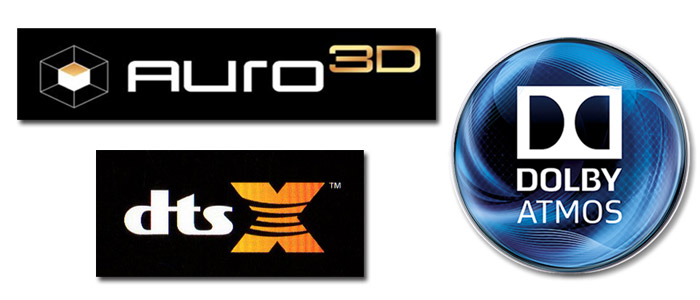
DTS:X will be the third major immersive sound format to hit the market, though to date there are no theatrical titles released or announced in the format. At this point, details on DTS:X are a bit sketchy thought the company promises that there will be more details available at the official DTS:X launch in March of this year. The company released a demo disc at CES this year with some tracks purported to be encoded in DTS:X (but we have no way of verifying that yet).
Immersive Sound can be channel-based (content is mixed for a specific pre-defined speaker layout) or object-based (sounds are stored with meta data that defines the sound's position in space along with speed and direction if the sound is moving). AURO-3D is channel-based, while Dolby Atmos is object-based. DTS has been working on object-based sound formats under different names for several years and we believe that DTS:X will also prove to be an object-based immersive surround sound format.
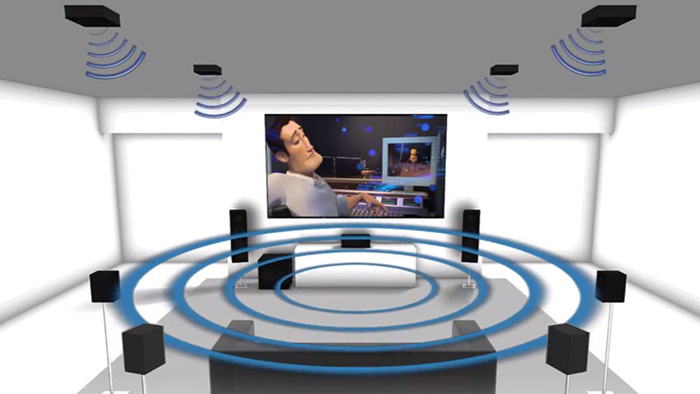
With AURO-3D, soundtracks are mixed for an 11-channel three-dimensional soundstage which includes channels at ear-level, channels above ear level (usually mounted high on a wall) and a channel directly overhead (the so-called "Voice of God" channel). For home use, AURO says that 9-channel and 10-channel speaker layouts are also supported. But these two distinct layers of height channels are a bit different from Dolby Atmos and DTS:X.
Dolby Atmos is object-based, with a 7.1.2-channel "bed" which is augmented by sound objects that can travel anywhere in space. At playback time, a Dolby Atmos processor renders the sound as precisely as it can for the particular speaker layout in the room. In theaters, Dolby Atmos supports up to 64 distinct speaker channels. In its home implementation, Dolby Atmos can support up to 34 channels (up to 24 ear level speakers and up to 10 height speakers above the listener). Details are not yet available about DTS:X speaker configurations.
Do I Care About Immersive Sound?
If you care about sound quality in films, you should care about immersive sound. With the inclusion of discrete height speakers, movie-makers can make a film sound much more realistic and immersive. Sound doesn't just come from around you but above you. Helicopter fly-overs, thunderstorms, swirling storms, exploding space stations all seem that much more realistic in immersive surround.
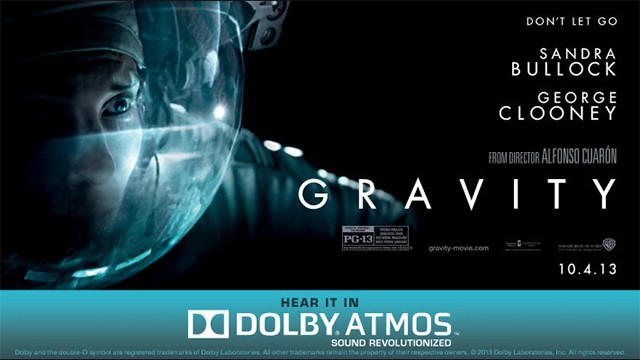
"Gravity" director Alfonso Cuarón has gone on record to say that immersive surround (in the form of Dolby Atmos) was as important to that film as 3D. "You really can explore the possibilities of depth and separation as never before." Find out more about what the director thinks about Atmos in this brief video interview. Dolby Atmos has been used to increase the immersiveness of dozens of other blockbuster films in theaters, including "Edge of Tomorrow," "Godzilla," "American Sniper," "Guardians of the Galaxy," all three of "The Hobbit" films and many more. Check out Dolby's list of movies released in Dolby Atmos.
AURO 11.1 surround encoding has also been used to similar effect in several films including "The Hunger Games: Mockingjay, Part One," "John Wick," and "Elysium." Interstingly, most of the recognizable AURO-3D titles were also released in theaters in Dolby Atmos, including "Transformers: Age of Extinction," "The Maze Runner," "Amazing Spiderman 2" and several more. Check out the full list of films released in AURO-11.1. In partnership with Barco, AURO-11.1 surround is also available in select theaters around the world.
How Can I See (and Hear!) a Movie in Immersive Sound?
According to Dolby, there are currently over 900 Dolby Atmos-equipped theaters worldwide, with five in New York City alone (where we are based). To find one near you, you can check the Dolby Atmos theater-finder. Be sure to double-check with the theater owner or theater listings before purchasing tickets as not all Dolby Atmos-enabled films play in Dolby Atmos surround, even in theaters that are properly equipped. Dolby Atmos is normally in the "premium" screening rooms in these theaters so only select showings will be in Dolby Atmos.
Through its partnership with Barco, AURO also has a wide selection of theaters equipped for AURO 11.1 playback, though many of these are located outside the United States. Auro says there are over 550 theater locations where AURO surround is committed or already installed. Check out the Auro theater finder on the AURO by Barco web site - AURO theater locator. Again, it's always best to check with the theater owner in advance to confirm AURO showtimes of particular films.
Can I Get Immersive Sound at Home?
Both Dolby Atmos and AURO-3D are available in select home products including receivers, preamps and (for Dolby) speakers. DTS:X is not yet available but DTS promises that announcements will be forthcoming in March at the official launch. So far, the only hardware manufactucturer to confirm inclusion of DTS:X decoding in one of their products is Steinway Lyngdorf whose P200 processor is expected to sell for around $18,000 in early 2015. DTS has gone on record to say that other respected audio brands including Anthem, Denon, Integra, Krell, Marantz, McIntosh, Onkyo, Outlaw Audio, Pioneer, Theta Digital, Trinnov Audio, and Yamaha will also offer products with DTS:X decoding.
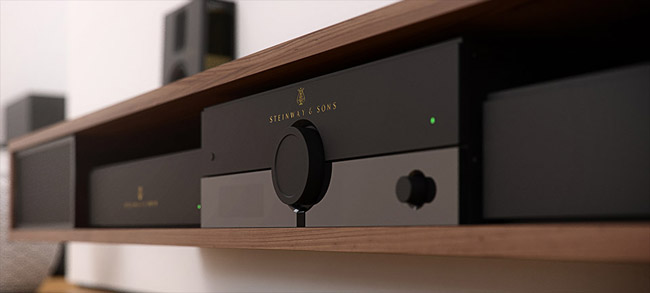
Of the three formats, Dolby Atmos has a significant headstart on the market at price points starting as low as $500 for an A/V receiver or $799 for a basic Dolby Atmos Home Theater in a Box system (receiver and speakers) ranging up to multi thousands of dollars for high-end preamp/processors from Trinnov and Steinway Lyngdorf. Check out our Dolby Atmos receiver buyer's guide or Dolby Atmos preamp/processor buyer's guide for more information. Several of the high-end Dolby Atmos receivers and preamp/processors (Denon, Marantz, Trinnov, Steinway Lyngdorf, AURO Technologies) also include or will include AURO-3D decoding.
You'll also need more speakers. For Dolby Atmos on most consumer gear, you start with a traditional 5.1-channel or 7.1-channel surround system and add two or four ceiling speakers, or two or four Dolby "elevation modules," also called "Atmos-enabled speakers." Dolby Atmos-enabled speakers bounce sound off the ceiling so it sounds like sound is coming from above you. Dolby Atmos elevation modules only work with flat, reflective, ceilings, no more than about 12 feet high. If that doesn't match your room layout then you'll need real in-ceiling speakers. Also, if you want a multi-format-capable system, then skip the Dolby Atmos elevation modules because they're currently incompatible with other immersive sound formats. For this reason, we'd recommend true in-ceiling speakers.

For AURO-3D, you'll want to add four height speakers (can be wall-mounted) above the regular speakers plus at least one overhead "Voice of God" speaker. AURO-3D's 10 and 11-channel layouts include two distinct layers of height, though we're told that AURO-3D does support implementations of a single height layer for home use as well (AURO-9.1, with no Voice-of-God speaker overhead).
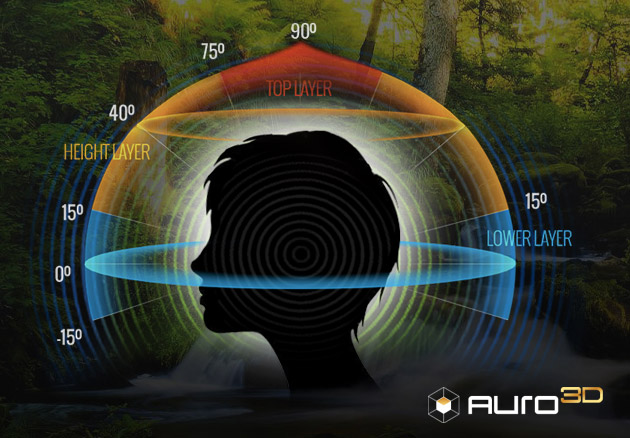
For DTS, we're assuming true ceiling speakers will be required as well, but we don't yet have details on the speaker layouts. DTS has hinted that DTS:X will be able to "virtualize" height speakers from a standard 5.1 or 7.1-speaker layout, as reported in TWICE Magazine. We'd have to hear that to believe it. They have done some pretty remarkable things with virtualization in DTS Headphone:X so we won't write that idea off entirely just yet. But we'd imagine the best results will come with real speakers mounted on the ceiling.
Dolby has adopted a new nomenclature for speaker layouts for Dolby Atmos. It's a 3-part number starting with the number of traditional surround speakers (ear level), followed by the number of subwoofers, followed by the number of height speakers. 5.1.2 would be five standard surround speakers (front left, center, front right, left surround and right surround) plus one subwoofer, plus two height speakers. 7.2.4 would be seven traditional surround speakers, two subwoofers and four height speakers.
AURO uses the more standard 9.1, 10.1 and 11.1 speaker designations but these are less descriptive as they don't identify what goes where. Auro-9.1 typically has a standard 5.1 surround augmented by 4 height speakers. Auro 10.1 adds a single Voice of God speaker directly above the listener. Auro 11.1 adds a center height speaker to the mix, so five down low, five up high, and one right above the listener.
What About Content? Can I Buy or Stream a Movie in Immersive Sound?
Aye, matey, therein lies the rub. To date, even with over 200 theatrical titles released or announced in Dolby Atmos, there are only four Blu-ray Discs available in the format, plus three more (including "Gravity") announced for Q1 of this year. And although it is technically possible to deliver Dolby Atmos in Dolby Digital Plus (on streaming services such as VUDU, Amazon and Netflix), no such titles are available for streaming in Dolby Atmos yet. VUDU did recently release a series of Dolby Atmos trailers in its library in order to show that it can deliver Dolby Atmos over its streaming service but so far, that's as far as it goes.
For AURO-3D, their web site lists seven Blu-rays with AURO-3D encoding (plus two demo discs available "upon request") but it appears that all of these are films or music releases from outside the US market (I didn't recognize any). Check the list yourself and see if any of these ring any bells.
Both Dolby Atmos and AURO-3D Blu-rays can be played back on most current Blu-ray Players without problems as they piggyback on existing audio codecs: Dolby Digital Plus and Dolby TrueHD for Dolby Atmos, and uncompressed PCM for AURO-3D. You will need a new Atmos- or AURO-enabled receiver or processor to extract the height information from the mix.
For DTS, the only clues we have so far are from a DTS demo disc given out at CES 2015. There are multiple movie clips on the demo disc that say that they are in "DTS-HD 7.1 | DTS:X" format. This implies that they are doing what Dolby does, making DTS:X backward compatible with the existing DTS-HD Master Audio codec on Blu-ray Disc.
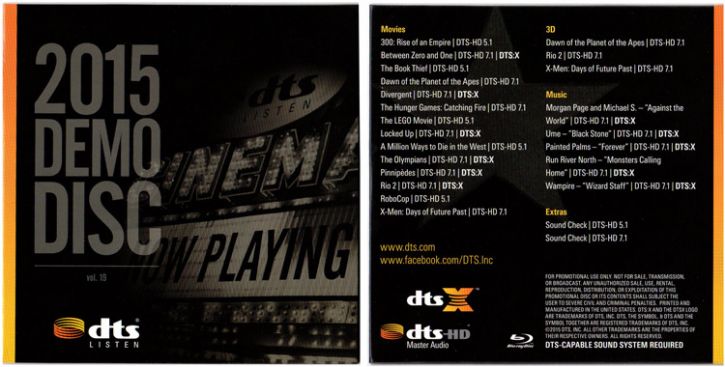
The clips on the DTS Demo Disc are mostly from documentaries or animated short films that I'd never heard of before. The only exceptions are "Divergent," which was not released in any immersive sound format in theaters, and "Rio 2" which was actually released in theaters in Dolby Atmos. Of course, having these clips on the disc does not necessarily mean the movies themselves will be available in DTS:X but it is encouraging.
It will be particularly interesting to see if DTS can repeat what they did with lossless surround formats on Blu-ray. Of all the Blu-ray Discs on the market with high quality lossless surround sound, about 75% of these titles are encoded in DTS-HD Master Audio (data courtesy of blu-raystats.com). The rest are split between Dolby TrueHD and PCM sound. Some movies which were released in Dolby 7.1 in theaters (like "Toy Story 3"), were released on Blu-ray in DTS-HD Master Audio 7.1 surround. Will the same happen with Dolby Atmos titles being release on Blu-ray Disc in DTS:X? The demo disc suggests that this is possible. Time will tell.
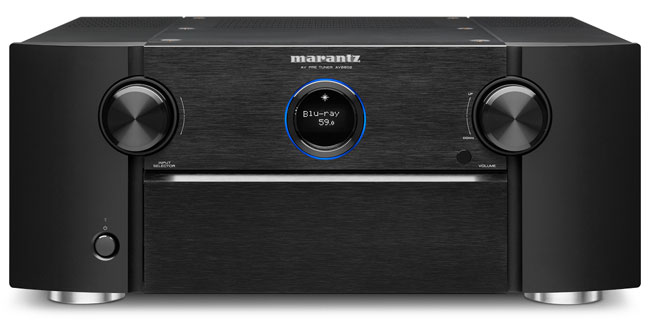
Should I Buy a New Receiver and Speakers Now or Should I Wait?
At this point, since DTS:X is a major fly in the ointment, we'd recommend waiting until at least March to buy a new receiver or preamp/processor. At that time, details on how and when DTS:X will be rolled out should be clearer than they are now. It's possible that DTS:X decoding may be added to receivers that are already on the market via firmware or software updates. It's also possible that those who want DTS:X decoding will have to wait until the 2015 model year receivers come out (usually in the summer and fall). So if you haven't bought a new receiver with immersive surround capabilities yet, it might be best to wait a little longer to see how things shape up.
Have an opinion on immersive sound? Let us know in the comments.
More Articles on Immersive Sound: